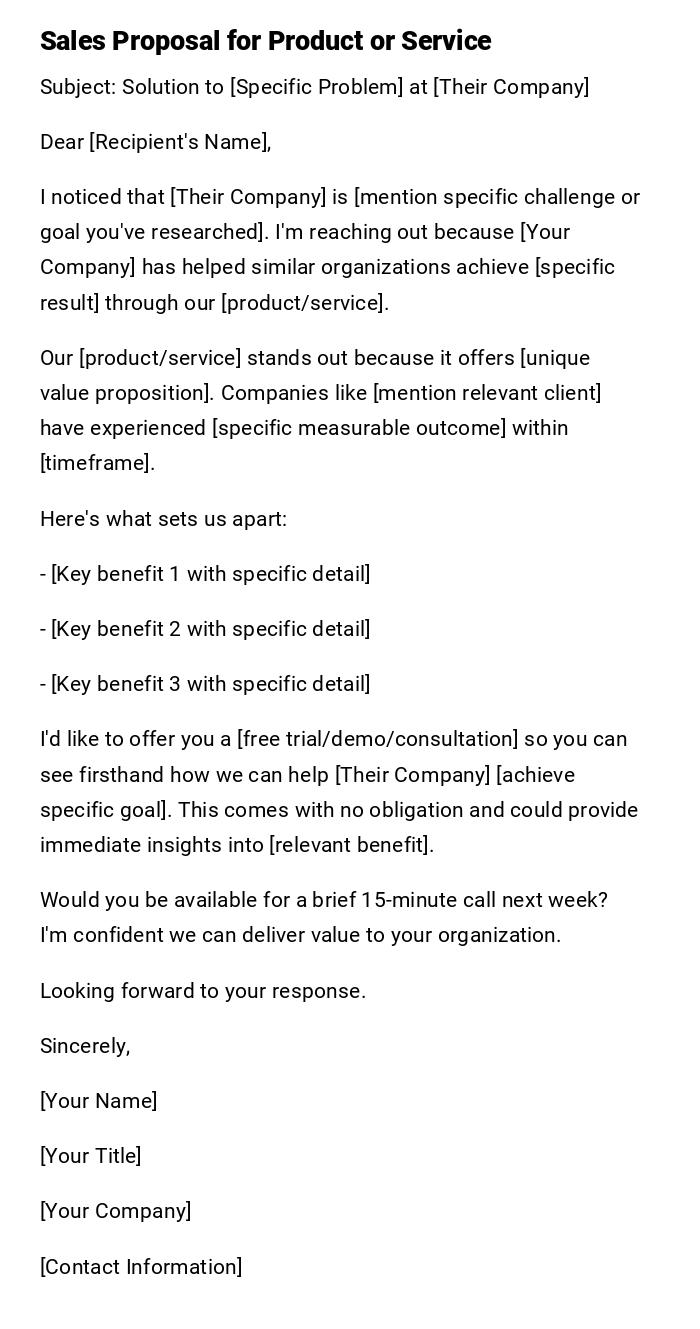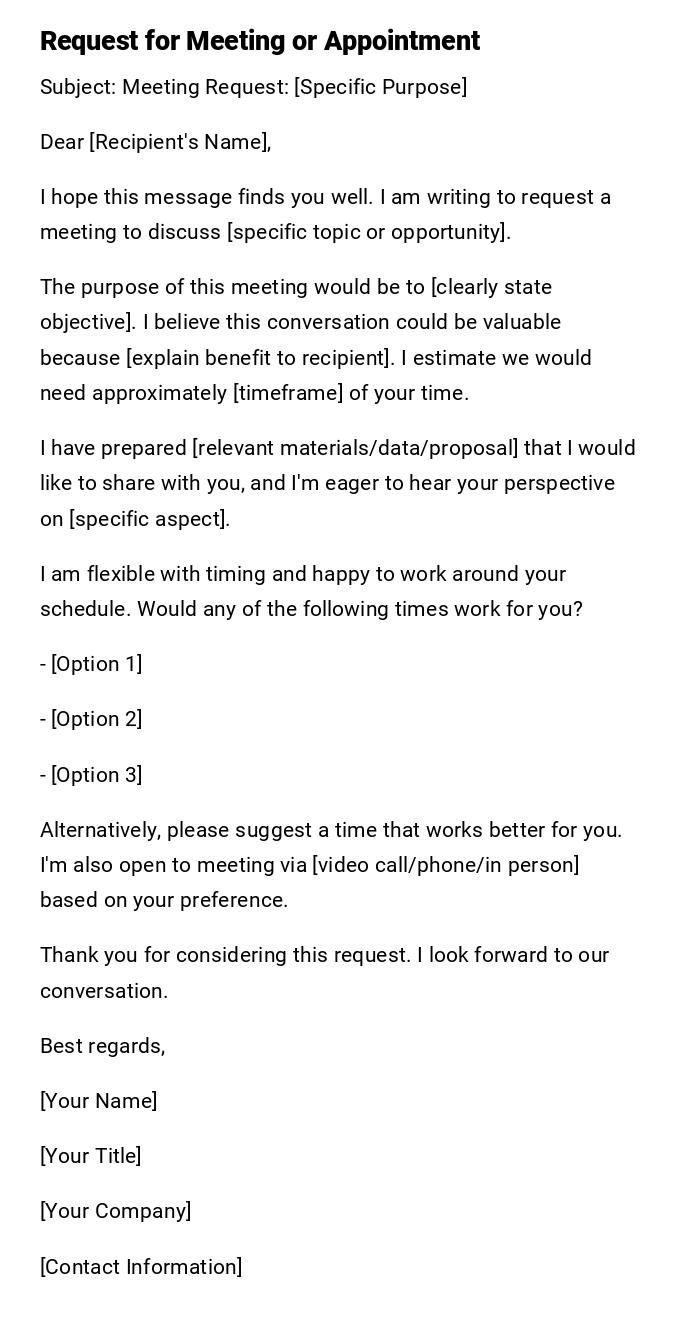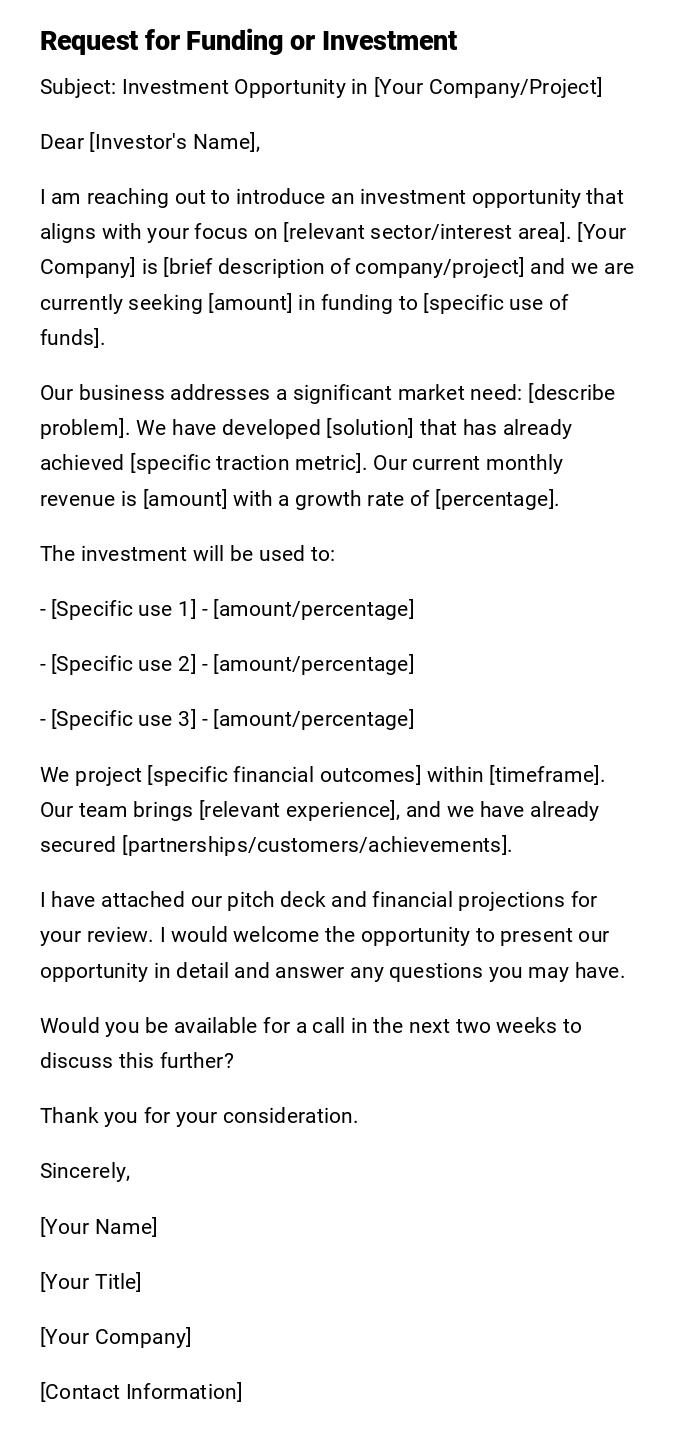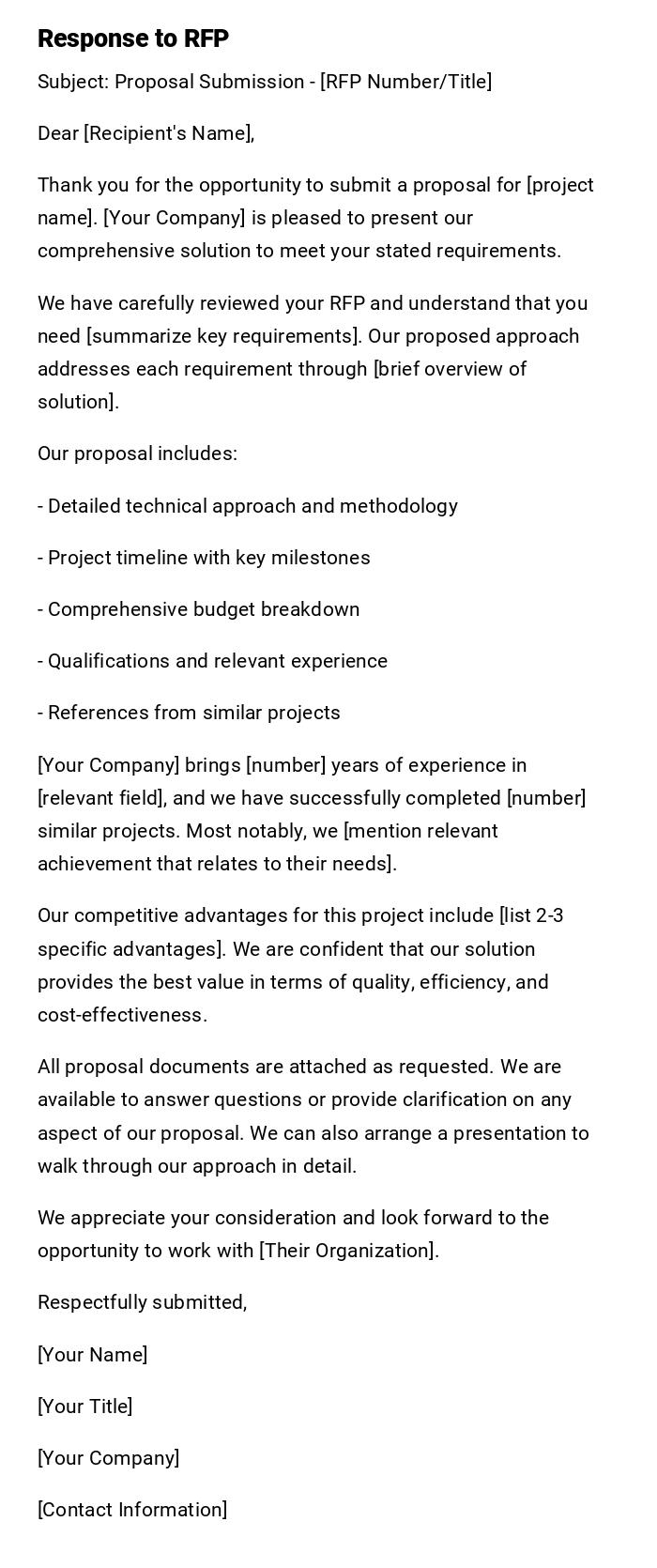Persuasive Business Letter Example
[Your Name]
[Your Title/Position]
[Your Company/Organization]
[Your Address]
[City, State, ZIP Code]
[Date]
[Recipient's Name]
[Recipient's Title/Position]
[Recipient's Company/Organization]
[Recipient's Address]
[City, State, ZIP Code]
Subject: Enhancing Your Company's Digital Marketing Strategy
Dear [Recipient's Name],
I hope this letter finds you in good health and high spirits. My name is [Your Name], and I represent [Your Company], a leading digital marketing agency dedicated to driving exceptional results for our clients. I am writing to propose a partnership that I believe will greatly benefit [Recipient's Company].
In today's ever-evolving business landscape, a robust and effective digital marketing strategy is crucial for maintaining a competitive edge. As I conducted an in-depth analysis of your company's online presence, I couldn't help but notice the untapped potential that lies within your current digital marketing efforts. With our expertise and dedication, we are confident that we can significantly enhance your online visibility and ultimately drive higher conversion rates.
Here are some key reasons why partnering with [Your Company] is a wise investment:
1. Proven Track Record: Over the past [number of years] years, we have helped numerous clients from various industries achieve remarkable success in their digital marketing endeavors. Our case studies and testimonials speak to our ability to deliver results consistently.
2. Customized Solutions: We understand that each business is unique, and there is no one-size-fits-all approach to digital marketing. Our team of skilled professionals will work closely with your team to develop a tailored strategy that aligns with your company's goals and values.
3. Multichannel Approach: Our expertise spans across various digital marketing channels, including search engine optimization (SEO), social media marketing, content creation, email marketing, and pay-per-click (PPC) advertising. We believe in a holistic approach that leverages the power of multiple channels to maximize your online reach.
4. Continuous Optimization: Our commitment to excellence drives us to continuously monitor and analyze campaign performance. By identifying opportunities for improvement, we can make data-driven decisions that lead to better outcomes and a higher return on investment.
5. Transparency and Communication: We value open and transparent communication with our clients. Throughout our partnership, you will receive regular progress reports and updates, allowing you to stay informed and confident in our approach.
I am excited about the prospect of working with [Recipient's Company] and believe that together, we can achieve remarkable growth in your digital presence. I would be delighted to arrange a meeting at your convenience to discuss the finer details of our proposal and answer any questions you may have.
Thank you for considering this partnership opportunity. I look forward to the possibility of collaborating with your esteemed organization. Please feel free to reach me at [Your Phone Number] or [Your Email Address].
Yours sincerely,
[Your Name]
[Your Title/Position]
[Your Company]
[Your Phone Number]
[Your Email Address]
Request for Partnership or Collaboration
Subject: Partnership Opportunity Between [Your Company] and [Their Company]
Dear [Recipient's Name],
I am writing to explore a potential partnership between [Your Company] and [Their Company]. Having followed your work in [industry/field], I believe our organizations share complementary strengths that could create significant value for both parties.
[Your Company] specializes in [your expertise], and we have successfully [mention relevant achievement]. We see an opportunity to combine our capabilities with your expertise in [their strength] to [specific goal or outcome].
I propose we schedule a meeting to discuss how we might work together on [specific project or ongoing collaboration]. This partnership could benefit both organizations by [list 2-3 specific benefits].
I would appreciate the opportunity to discuss this proposal at your earliest convenience. Please let me know your availability for a call or meeting in the coming weeks.
Thank you for considering this opportunity. I look forward to exploring how we can create mutual success.
Best regards,
[Your Name]
[Your Title]
[Your Company]
[Contact Information]
Sales Proposal for Product or Service
Subject: Solution to [Specific Problem] at [Their Company]
Dear [Recipient's Name],
I noticed that [Their Company] is [mention specific challenge or goal you've researched]. I'm reaching out because [Your Company] has helped similar organizations achieve [specific result] through our [product/service].
Our [product/service] stands out because it offers [unique value proposition]. Companies like [mention relevant client] have experienced [specific measurable outcome] within [timeframe].
Here's what sets us apart:
- [Key benefit 1 with specific detail]
- [Key benefit 2 with specific detail]
- [Key benefit 3 with specific detail]
I'd like to offer you a [free trial/demo/consultation] so you can see firsthand how we can help [Their Company] [achieve specific goal]. This comes with no obligation and could provide immediate insights into [relevant benefit].
Would you be available for a brief 15-minute call next week? I'm confident we can deliver value to your organization.
Looking forward to your response.
Sincerely,
[Your Name]
[Your Title]
[Your Company]
[Contact Information]
Request for Meeting or Appointment
Subject: Meeting Request: [Specific Purpose]
Dear [Recipient's Name],
I hope this message finds you well. I am writing to request a meeting to discuss [specific topic or opportunity].
The purpose of this meeting would be to [clearly state objective]. I believe this conversation could be valuable because [explain benefit to recipient]. I estimate we would need approximately [timeframe] of your time.
I have prepared [relevant materials/data/proposal] that I would like to share with you, and I'm eager to hear your perspective on [specific aspect].
I am flexible with timing and happy to work around your schedule. Would any of the following times work for you?
- [Option 1]
- [Option 2]
- [Option 3]
Alternatively, please suggest a time that works better for you. I'm also open to meeting via [video call/phone/in person] based on your preference.
Thank you for considering this request. I look forward to our conversation.
Best regards,
[Your Name]
[Your Title]
[Your Company]
[Contact Information]
Request for Funding or Investment
Subject: Investment Opportunity in [Your Company/Project]
Dear [Investor's Name],
I am reaching out to introduce an investment opportunity that aligns with your focus on [relevant sector/interest area]. [Your Company] is [brief description of company/project] and we are currently seeking [amount] in funding to [specific use of funds].
Our business addresses a significant market need: [describe problem]. We have developed [solution] that has already achieved [specific traction metric]. Our current monthly revenue is [amount] with a growth rate of [percentage].
The investment will be used to:
- [Specific use 1] - [amount/percentage]
- [Specific use 2] - [amount/percentage]
- [Specific use 3] - [amount/percentage]
We project [specific financial outcomes] within [timeframe]. Our team brings [relevant experience], and we have already secured [partnerships/customers/achievements].
I have attached our pitch deck and financial projections for your review. I would welcome the opportunity to present our opportunity in detail and answer any questions you may have.
Would you be available for a call in the next two weeks to discuss this further?
Thank you for your consideration.
Sincerely,
[Your Name]
[Your Title]
[Your Company]
[Contact Information]
Response to RFP (Request for Proposal)
Subject: Proposal Submission - [RFP Number/Title]
Dear [Recipient's Name],
Thank you for the opportunity to submit a proposal for [project name]. [Your Company] is pleased to present our comprehensive solution to meet your stated requirements.
We have carefully reviewed your RFP and understand that you need [summarize key requirements]. Our proposed approach addresses each requirement through [brief overview of solution].
Our proposal includes:
- Detailed technical approach and methodology
- Project timeline with key milestones
- Comprehensive budget breakdown
- Qualifications and relevant experience
- References from similar projects
[Your Company] brings [number] years of experience in [relevant field], and we have successfully completed [number] similar projects. Most notably, we [mention relevant achievement that relates to their needs].
Our competitive advantages for this project include [list 2-3 specific advantages]. We are confident that our solution provides the best value in terms of quality, efficiency, and cost-effectiveness.
All proposal documents are attached as requested. We are available to answer questions or provide clarification on any aspect of our proposal. We can also arrange a presentation to walk through our approach in detail.
We appreciate your consideration and look forward to the opportunity to work with [Their Organization].
Respectfully submitted,
[Your Name]
[Your Title]
[Your Company]
[Contact Information]
Request for Information or Action
Subject: Request for [Specific Information/Action]
Dear [Recipient's Name],
I am writing to request [specific information or action needed]. This information is necessary for [explain purpose or context].
Specifically, I need the following:
- [Item 1 with any relevant details]
- [Item 2 with any relevant details]
- [Item 3 with any relevant details]
This request relates to [provide context or background]. Having this information by [specific date] would allow us to [explain benefit or reason for timeline].
If you need any clarification about this request or require additional information from our end, please don't hesitate to reach out. I am happy to provide [any supporting materials you can offer].
I understand you may have a busy schedule, and I appreciate your attention to this matter. If the requested timeline presents any challenges, please let me know and we can discuss alternatives.
Thank you for your assistance with this request.
Kind regards,
[Your Name]
[Your Title]
[Your Company]
[Contact Information]
Introduction to New Contact or Stakeholder
Subject: Introduction and Potential Opportunity
Dear [Recipient's Name],
My name is [Your Name], and I am the [Your Title] at [Your Company]. I was referred to you by [Referral Name/or: came across your profile/work], and I wanted to reach out to introduce myself.
[Your Company] specializes in [what you do], and we work with organizations like [mention relevant examples] to [achieve specific outcomes]. I believe there may be opportunities for us to connect based on [specific reason related to their work or interests].
I'm particularly impressed by [mention something specific about their work or company]. It seems we share an interest in [common ground or industry focus].
I don't want to take up too much of your time with this initial message, but I would value the opportunity to learn more about your work and explore whether there might be ways we could collaborate or support each other's goals.
Would you be open to a brief introductory call? I'm happy to work around your schedule.
Thank you for considering this introduction. I look forward to potentially connecting.
Best regards,
[Your Name]
[Your Title]
[Your Company]
[Contact Information]
Customer Win-Back or Re-engagement Email
Subject: We'd Love to Have You Back
Dear [Customer's Name],
We noticed you haven't [used our service/made a purchase/engaged with us] in a while, and we miss having you as part of the [Company Name] community.
We value your past business and want to understand how we can better serve you. We've made several improvements since you last [interacted with us], including [list 2-3 specific improvements or new features].
To welcome you back, we'd like to offer you [specific incentive]. This is our way of saying thank you for being a valued customer and showing you what's new.
We'd also appreciate any feedback you might have about your previous experience. Your insights help us improve and better serve customers like you.
If you're interested in giving us another try, simply [clear call to action]. This offer is available until [expiration date].
If you prefer not to hear from us, I understand, and you can unsubscribe using the link below.
We hope to see you again soon.
Warm regards,
[Your Name]
[Your Title]
[Your Company]
[Contact Information]
What is a Persuasive Business Letter and Why You Need One
A persuasive business letter is a formal or semi-formal written communication designed to convince the recipient to take a specific action, accept a proposal, or change their perspective on a business matter. Unlike informational letters, persuasive letters actively advocate for a particular outcome.
- Core purpose: To influence decision-making and prompt action through logical arguments, evidence, and appeal to the recipient's interests
- Strategic tool: Serves as a documented, professional approach to business negotiations and requests
- Relationship builder: Maintains professionalism while advocating for your position
- Versatile application: Used in sales, partnerships, funding requests, policy changes, and various business scenarios
- Persuasion over information: Focuses on benefits, solutions, and value propositions rather than just facts
Who Should Send Persuasive Business Letters
- Business owners and entrepreneurs: Seeking partnerships, investments, or new business opportunities
- Sales professionals: Proposing products or services to potential clients
- Marketing managers: Pitching campaigns or requesting budget increases
- Project managers: Requesting resources, approvals, or stakeholder buy-in
- Consultants and freelancers: Proposing services to prospective clients
- Department heads: Advocating for policy changes or additional resources
- Account managers: Re-engaging lapsed clients or upselling existing customers
- Executives and directors: Requesting board approval or investor funding
- Anyone seeking to influence a business decision: Whether internal or external to your organization
When to Send Persuasive Business Letters
- New business opportunities: When you identify a potential partnership, collaboration, or sales prospect
- Funding needs: When seeking investment, loans, or budget allocation
- RFP responses: When responding to formal requests for proposals
- Customer churn: When valuable clients become inactive or cancel services
- Market expansion: When proposing entry into new markets or product lines
- Problem-solving: When proposing solutions to organizational challenges
- Competitive situations: When you need to differentiate your offer from alternatives
- Relationship milestones: After initial meetings when you need to advance the conversation
- Policy advocacy: When requesting changes to procedures, policies, or approaches
- Resource requests: When you need approval for additional budget, staff, or tools
Key Elements and Structure of Persuasive Business Letters
- Compelling subject line: Clear, specific, and benefit-focused (for emails)
- Professional salutation: Personalized greeting using recipient's name
- Strong opening: Hook that captures attention and establishes relevance immediately
- Context and credibility: Brief background that establishes your authority and understanding
- Clear value proposition: Explicit statement of what you're offering and why it matters
- Evidence and proof: Data, testimonials, case studies, or concrete examples
- Benefits focus: Emphasis on outcomes for the recipient rather than features of your offer
- Anticipate objections: Address potential concerns before they're raised
- Call to action: Specific, clear next step you want the recipient to take
- Professional closing: Courteous sign-off that maintains relationship focus
- Complete contact information: Multiple ways for recipient to respond
- Attachments: Supporting documents, proposals, or additional materials when relevant
How to Write an Effective Persuasive Business Letter
- Research thoroughly: Understand your recipient's business, challenges, and priorities before writing
- Define your objective: Be crystal clear about what action you want the recipient to take
- Lead with benefits: Focus on what the recipient gains rather than what you want
- Use the AIDA model: Attention, Interest, Desire, Action - structure your letter to guide the reader through these stages
- Be specific and concrete: Replace vague claims with precise data, examples, and outcomes
- Tell stories: Use brief case studies or scenarios that demonstrate your point
- Address the recipient directly: Use "you" and "your" to make it personal and relevant
- Keep it concise: Respect the reader's time by being direct and eliminating unnecessary words
- Create urgency appropriately: Give legitimate reasons why timely action matters
- End with clarity: Make the next step obvious and easy to take
- Proofread meticulously: Errors undermine credibility and persuasiveness
Formatting Best Practices for Persuasive Business Letters
- Length: Keep to one page for physical letters; 200-400 words for emails
- Tone: Professional but warm; confident without arrogance; enthusiastic without desperation
- Paragraph structure: Short paragraphs (2-4 sentences) for better readability
- White space: Use adequate spacing to prevent overwhelming the reader
- Bullet points: Employ strategically for lists of benefits, features, or requirements
- Font choice: Traditional business fonts (Times New Roman, Arial, Calibri) in 11-12pt
- Emphasis: Bold sparingly for key points; avoid underlining or excessive capitalization
- Mobile optimization: For emails, ensure formatting displays well on mobile devices
- Professional signature: Include full contact details and relevant titles
- Attachment etiquette: Reference attachments in the letter body; use clear file names
- Delivery method: Match formality to relationship (formal printed letter vs. email)
Common Mistakes to Avoid in Persuasive Business Letters
- Being too pushy or aggressive: Desperation and pressure tactics damage relationships and credibility
- Focusing on yourself rather than the recipient: "I need" versus "you will benefit" creates different responses
- Making unsupported claims: Vague promises without evidence fail to convince
- Writing too long: Burying your main point in excessive text loses reader attention
- Generic, template-feel: Failing to personalize makes recipients feel unimportant
- Ignoring objections: Pretending concerns don't exist makes you seem naive or dishonest
- Weak or missing call-to-action: Leaving next steps ambiguous results in no action
- Poor timing: Sending during busy periods or without considering recipient's calendar
- Grammatical errors: Mistakes signal carelessness and unprofessionalism
- Attacking competitors: Negative approaches often backfire; focus on your strengths
- Overpromising: Setting unrealistic expectations damages long-term credibility
- Forgetting follow-up: Assuming one letter will do all the work without planning next steps
What to Do After Sending Your Persuasive Business Letter
- Track delivery: Confirm the letter was received (especially for important proposals)
- Wait appropriately: Give 3-5 business days for email; 7-10 days for physical mail before following up
- Send a polite follow-up: Reference your original letter and gently inquire about their thoughts
- Be available: Ensure you can respond quickly to any questions or requests for information
- Prepare for objections: Have responses ready for common concerns or questions
- Document interactions: Keep records of all correspondence for future reference
- Respect their decision: If declined, thank them professionally and leave door open for future opportunities
- Request feedback: When appropriate, ask for insights even if the answer is no
- Maintain the relationship: Continue engaging professionally regardless of immediate outcome
- Adjust your approach: Learn from responses to improve future persuasive letters
- Set reminders: Schedule follow-ups in your calendar to ensure persistence without being forgotten
Requirements and Prerequisites Before Sending
- Decision-maker identification: Confirm you're addressing the person with authority to act
- Research completion: Gather information about the recipient's company, role, and current situation
- Value proposition clarity: Articulate exactly what you offer and why it matters
- Supporting materials: Prepare any documents, data, or references you'll need to include
- Proof points ready: Collect testimonials, case studies, or metrics that support your claims
- Contact information verified: Ensure recipient's name, title, and address are current and correct
- Internal approval: Get necessary sign-offs if representing an organization
- Budget or capacity confirmation: Ensure you can deliver on what you're proposing
- Timing validation: Verify this is an appropriate time for your request (avoid busy seasons, known conflicts)
- Alternative solutions considered: Be prepared to discuss different approaches if your primary proposal needs adjustment
- Legal review: For contracts or binding proposals, ensure compliance with relevant regulations
Pros and Cons of Persuasive Business Letters
Advantages:
- Professional documentation: Creates formal record of your proposal or request
- Thoughtful presentation: Allows you to carefully craft arguments without interruption
- Time for consideration: Recipients can review and reflect on your proposal thoroughly
- Wide reach: Can approach prospects you couldn't easily meet in person
- Cost-effective: Relatively inexpensive compared to in-person sales calls
- Scalability: Template approaches can be personalized for multiple recipients
- Reference material: Recipients can share with colleagues or refer back later
Disadvantages:
- No immediate feedback: Can't adjust approach based on real-time reactions
- Easy to ignore: Recipients can delete or discard without reading
- Competition for attention: Competes with numerous other messages daily
- Limited persuasion tools: Can't use voice tone, body language, or interactive discussion
- Delayed response: May take days or weeks to receive answer, if any
- Misinterpretation risk: Written words can be misunderstood without clarifying dialogue
- One-way communication: Doesn't build relationship as effectively as conversation
Comparing Persuasive Letters to Alternative Approaches
Persuasive Letter vs. Phone Call:
- Letters allow detailed, uninterrupted presentation; calls enable real-time objection handling
- Letters are less intrusive but easier to ignore than direct conversation
- Calls build rapport faster but require scheduling and coordination
Persuasive Letter vs. In-Person Meeting:
- Meetings are more effective for complex negotiations but require significant time investment
- Letters can reach decision-makers who wouldn't grant meetings initially
- Meetings allow relationship building; letters are better for initial outreach
Persuasive Letter vs. Proposal Document:
- Proposals are comprehensive and formal; letters are concise and action-focused
- Letters often precede proposals, serving as executive summary or introduction
- Proposals require more preparation time but provide complete detail
Email vs. Physical Letter:
- Emails are faster, cheaper, and easier to track
- Physical letters stand out and signal importance through extra effort
- Emails allow immediate action with embedded links; letters feel more formal
Best practice: Use persuasive letters as part of multi-touch strategy, not standalone approach
Tips and Best Practices for Maximum Impact
- The 24-hour rule: Draft your letter but wait a day before sending to review with fresh eyes
- Mirror their language: Use terminology and phrases common in the recipient's industry
- Power of PS: Add a postscript with a compelling final thought—people often read this first
- Social proof strategically: Mention recognizable clients or partners when relevant
- Scarcity and exclusivity: When genuine, limited-time offers or exclusive opportunities increase response
- Question technique: Start with a thought-provoking question that engages the reader immediately
- Reciprocity principle: Offer something valuable upfront (insight, resource, trial) to encourage response
- Test subject lines: For email campaigns, A/B test different subject approaches
- Use active voice: "We will increase your efficiency" beats "Efficiency will be increased"
- Name-drop appropriately: Mention mutual connections or referral sources early if applicable
- Create visual breaks: Use formatting to guide eyes to key points without overwhelming
- End with confidence: Final sentence should exude certainty about the value you bring
Frequently Asked Questions About Persuasive Business Letters
How long should I wait before following up? Wait 3-5 business days for emails, 7-10 days for physical mail. Send a polite reminder referencing your original letter.
Should I send via email or physical mail? Email is standard for most business communication. Use physical mail for high-value proposals, senior executives, or when you want to stand out.
Can I send the same letter to multiple recipients? Avoid mass-mailing identical letters. Personalize key elements like opening, specific pain points, and examples for each recipient.
What if I don't get a response? Follow up 2-3 times over several weeks. If still no response, try different communication channels or accept they're not interested currently.
How formal should my tone be? Match the recipient's industry and culture. Tech startups may prefer casual; law firms expect formal. When unsure, lean slightly formal.
Should I include pricing in the initial letter? For sales letters, provide pricing ranges or starting points. For complex proposals, indicate you'll provide detailed pricing upon discussion.
Is it okay to use templates? Templates provide structure, but customize extensively. Generic letters are immediately recognizable and ineffective.
How do I handle rejection? Respond graciously, thank them for consideration, ask for feedback if appropriate, and maintain the relationship for future opportunities.










 Download Word Doc
Download Word Doc
 Download PDF
Download PDF